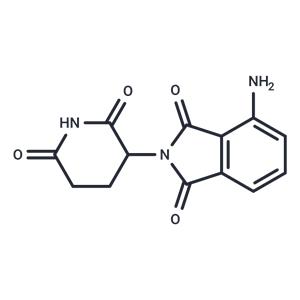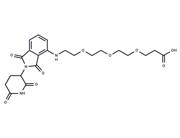| Name | Pomalidomide |
| Description | Pomalidomide (CC-4047) is an anti-angiogenic and immunomodulatory agent. Pomalidomide is a ligand for the ubiquitin E3 ligase cereblon (CRBN) and is commonly used in the synthesis of PROTAC products. |
| Cell Research | In vitro effects of either CC-5013 or CC-4047 as single agent or in combination with rituximab were evaluated by flow cytometric analysis. Lymphoma cell lines (1 × 10^6 cells) were exposed to either CC-5013 (5 μg/mL), CC-4047 (5 μg/mL), or vehicle control (DMRIE-C, 0.01%) alone or in combination with rituximab at a final concentration of 10 μg/mL. Following a period of incubation of 24 or 48 hours, apoptosis was assessed by staining-treated cells with FITC-labeled Annexin V and propidium iodine. All samples were analyzed by multicolor flow cytometric analysis using a fluorescence-activated cell sorter/FACStar Plus flow cytometer. Cells were scored as apoptotic if they were Annexin V–positive and propidium iodine–negative/positive (early and late apoptosis, respectively) [2]. |
| Kinase Assay | TNF-α inhibitory activity is measured in lipopolysacharide (LPS) stimulated PBMC. Pomalidomide is added to human PBMCs 1 hour prior to the addition of LPS (1 μg/mL) and incubation continued for an additional 18-20 hours. Supernatants are then harvested, and the concentration of TNF-α in the supernatants is determined by ELISA. The concentration of Pomalidomide that IC50 is calculated by nonlinear regression analysis [1]. |
| Animal Research | These studies were carried out using a disseminated lymphoma-bearing SCID mouse xenograft model. Raji cells were harvested from confluent cultures and only suspensions with >90% viable cells were used for animal inoculation. Subsequently, on day 0, SCID mice received 1 ×10^6 Raji cells via i.v. Untreated SCID mice inoculated by i.v. injection develop symptomatic central nervous system, pulmonary, and liver metastasis that result in death from massive tumor burden and central nervous system involvement after 17 to 21 days after inoculation. A second lymphoma mouse model was used to address the significance of NK cell expansion in the biological interactions observed between rituximab and IMiDs. The second mouse lymphoma xenograft consisted of SCID mice depleted of NK cells bearing Raji cells implanted via tail vein injection as described above [2]. |
| In vitro | METHODS: Multiple myeloma cells RPMI8226 and OPM2 were treated with Pomalidomide (0.01-50 µM) for 48 h. Cell viability was measured by MTT assay.
RESULTS: Pomalidomide significantly decreased the cell viability of RPMI8226 and OPM2 cells at 48 h with IC50 values of 8 µM and 10 µM, respectively.[1]
METHODS: Multiple myeloma cells H929, U266 and MM.1s were treated with Pomalidomide (0.05-1 µM) and ACY-241 (3 µM) for 4 days and apoptosis was detected by Flow cytometry.
RESULTS: Apoptosis was significantly increased when the two drugs were combined relative to either single drug. [2] |
| In vivo | METHODS: To assess the potential value in cerebral ischemia, Pomalidomide (50 mg/kg, 1% carboxy methyl cellulose) was administered intraperitoneally once daily for 21 days to transgenic mice chronically overexpressing the TNF-α surface-active protein (SP)-C promoter (SP-C/TNF-α mice).
RESULTS: Pomalidomide significantly reduced serum TNF-α and IL-5 levels. [3] |
| Storage | Powder: -20°C for 3 years | In solvent: -80°C for 1 year | Shipping with blue ice/Shipping at ambient temperature. |
| Solubility Information | H2O : < 1 mg/mL (insoluble or slightly soluble)
DMSO : 50 mg/mL (182.99 mM), Sonication is recommended.
Ethanol : < 1 mg/mL (insoluble or slightly soluble)
10% DMSO+40% PEG300+5% Tween 80+45% Saline : 5.4 mg/mL (19.76 mM), Suspension.
|
| Keywords | TNF-α | Pomalidomide | MolecularGlues | Molecular Glues | Ligands for E3 Ligase | LigandforE3Ligase | Ligand for E3 Ligase | Inhibitor | inhibit | E3 ligase-recruiting Moiety | CC4047 | CC 4047 | Apoptosis |
| Inhibitors Related | Kaolin | Stavudine | Aceglutamide | Tamoxifen | Urea | Cysteamine hydrochloride | Metronidazole | Citric Acid Triammonium | Dimethyl phthalate | Alginic acid | 3-Indoleacetic acid | Dextran sulfate sodium salt (MW 5000) |
| Related Compound Libraries | Failed Clinical Trials Compound Library | Bioactive Compound Library | EMA Approved Drug Library | Anti-Cancer Clinical Compound Library | Drug Repurposing Compound Library | Anti-Cancer Approved Drug Library | FDA-Approved Drug Library | Anti-Aging Compound Library | Immunology/Inflammation Compound Library | Bioactive Compounds Library Max | Anti-Cancer Drug Library | Anti-Cancer Active Compound Library |

 United States
United States






